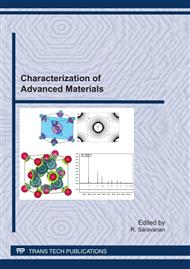[1]
Azojomo: Journal of Materials online, synthesis of CdS nanoparticles (ISSN 1833-122X) Volume 1, December (2005).
Google Scholar
[2]
Q. Wang, G. Xu, G. Han: J. Solid State Chem, 178, 2680, (2005).
Google Scholar
[3]
Q. Nie, Q. Yuan, W. Chen: J. Cryst. Growth 265, 420, (2004).
Google Scholar
[4]
X. Ma, F. Xu, Z. Zhang: Mater, Res. Bull. 40, 2180, (2005).
Google Scholar
[5]
Y. Wang, C. Y. To, D.H.L. Ng: Mater. Lett, 60, 1151(2006).
Google Scholar
[6]
R. Romano, O.L. Alves: Mater, Res. Bull, 41, 376 (2006).
Google Scholar
[7]
Y. Yang, H. Chen, X. Bao: J. Cryst, Grow. 252, 251 (2003).
Google Scholar
[8]
S. Prabhahar, N. Suryanarayanan, D. Kathirvel: Chalcogenide letters 6, 577(2009).
Google Scholar
[9]
J.H. Schon, O. Schenker, B. Batlogg: Thin Solid Film, 385, 271 (2001).
Google Scholar
[10]
V. Singh, P. Chaugan: Chalcogenide Letters 6, 421(2009).
Google Scholar
[11]
R. Bhattacharya and S. saha: Growth of CdS nano particle by chemical method and its characterization. Pramana Journal of physics 71: 187-192, (2008).
DOI: 10.1007/s12043-008-0152-7
Google Scholar
[12]
M. M. Wolfson, an Introduction to X-ray Crystallography, Cambridge Univ. Press, London, (1970).
Google Scholar
[13]
H.M. Rietveld: J. Appl. Crystallogr. 2, 65 (1969).
Google Scholar
[14]
G.H. Stout and L.H. Jensen: X-ray Structure Determination - A Practical Guide, 2nd Edn, Wiley, New York, p.24, (1989).
Google Scholar
[15]
Makoto Sakata and Masumi Sato by Accurate structure by the maximum entropy method journal of physics and chemistry of solids 1721-1724, volume A46, 263-270, and (1999).
Google Scholar
[16]
Fujio Izumi, Ruben A. Dilanien, National institute of material science, super fast program, PRIMA, for the maximum entropy method advanced materials laboratory, Japan (2004).
Google Scholar
[17]
K. Momma and F. Izumi, J. Appl. Crystallogr, commission on crystallographic computation, IUCV. News letter, No. 7, 106, (2006).
Google Scholar
[18]
R Saravanan, K S Syed and S Israel, Pramana: – J. Phys. Vol. 70, No. 4, April (2008).
Google Scholar
[19]
I. K. Jeong, J. Thompson, Th. Proffen, A. Perez, S.J.L. Billnge, PDFGetX: A program.
Google Scholar
[20]
C.L. Farrow, P. Juhăs, J.W. Liu, D. Bryndin, E.S. Bozin, J. Bloch, Th. Proffen S.J.L. Billange, PDFFit2 and PDFgui: J. Phy. Condens. Matter Vol. 19, 335219(2007).
DOI: 10.1088/0953-8984/19/33/335219
Google Scholar
[21]
J.D. Verhoven: Fundamentals of Physical Metallurgy, Wiley, New York, p.326, (1975).
Google Scholar
[22]
R. Saravanan, GRAIN software, www. saraxraygroup. net.
Google Scholar
[23]
Pankove has the same equation, but with an apparently different prefactor a however, in the Pankove version, the units dimensional analysis appears.
Google Scholar


